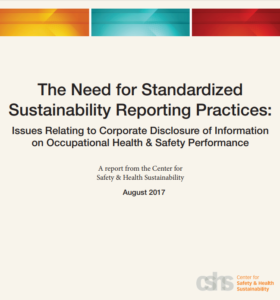
The Center for Safety and Health Sustainability (CSHS), whose member organizations represent more than 100,000 workplace safety and health professionals around the world, has released a report on its second analysis of how recognized “sustainable” companies report occupational injuries, illnesses and fatalities. The Need for Standardized Sustainability Reporting Practices is a step forward in showing how global initiatives that index corporate sustainability can include companies’ commitment to safe and healthy workers.
“We’ve learned through our two studies that voluntary sustainability reporting lacks rigor and fails to yield the meaningful data needed to effectively evaluate corporate safety and health performance,” said Kathy A. Seabrook, chair of the CSHS Board of Directors. “The disclosure of data needs to be standardized to help put companies on a truly holistic path to sustainability that recognizes the well-being of workers along with the environment.”
Organizations that rate corporations on sustainability collect voluntary data on environmental responsibility. CSHS’s goal is for organizations to incorporate worker safety and health as part of their sustainable business practices. Safety performance indicators allow companies to compare themselves and better understand where to enhance safety. “Similar to how environmental data is reported in sustainability efforts, a core set of safety and health metrics would help businesses measure achievements in managing human capital,” Seabrook said.
CSHS’s new report – a follow-up to its 2013 study – again focused on the Corporate Knights’ Global 100 Most Sustainable Corporations. It analyzed publicly reported data between June and December of 2016, identifying changes in reporting practices over the past four years related to occupational safety and health sustainability.
This second study showed sustainable corporations made little improvement in complying with common safety and health performance indicators. The study found high variability on data collection methodology, reporting formats, and terms and definitions used in reporting. The results indicate that companies are still far from reaching a consensus on the workplace safety and health metrics that should be included in global sustainability indexes.
“Understanding more fully these challenges brings us closer to CSHS’s goals,” Seabrook said.
The report calls for the adoption of two key indicators on occupational safety and health management systems – tracking how many of a company’s work locations implement such systems, and how many are audited by an independent third party. CSHS also suggests that businesses measure workplace safety and health in their supply chains. One sustainability leader reported no employee fatalities, but did report 27 deaths in its supply chain.
“A high sustainability performance rating rings hollow if the business fails to keep its workers safe and healthy,” Seabrook said. “New levels of collaboration and compromise are needed among sustainability reporting groups if we are to significantly reduce workplace injuries, illnesses and deaths.”
Review the latest CSHS report in its entirety by clicking here.



